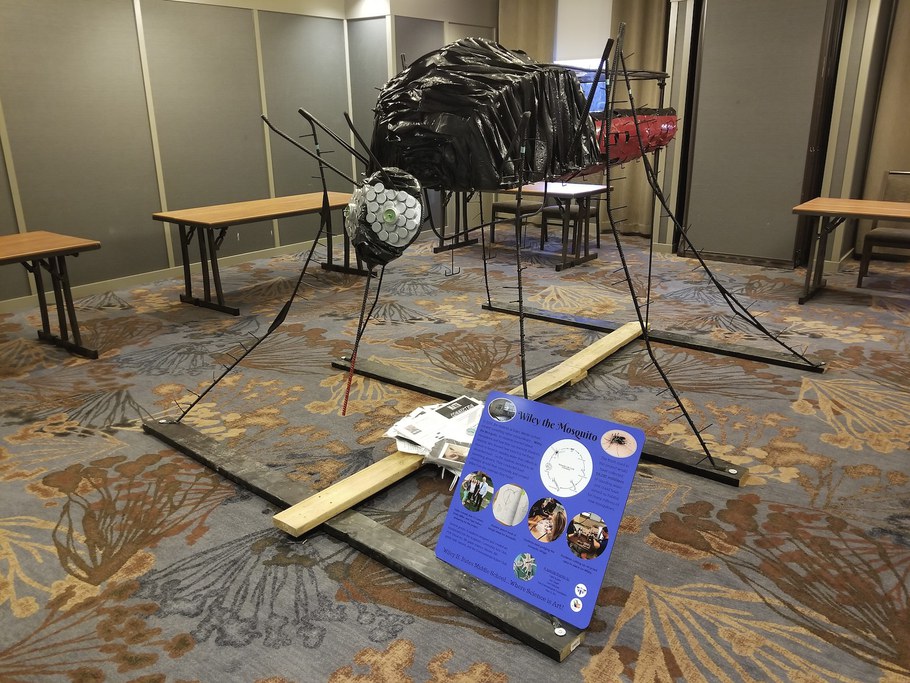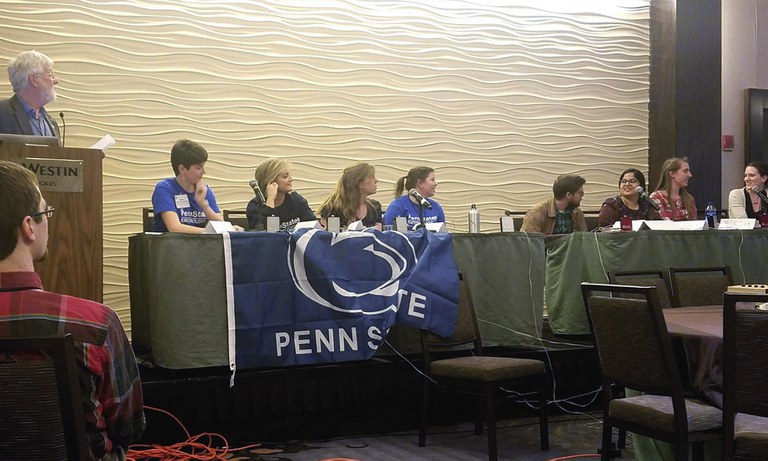Posted: May 2, 2018
Students and faculty from Penn State’s Departments of Entomology, Biology, and Plant Science attended the 89th Annual Meeting of the Eastern Branch of the Entomological Society of America (EB ESA). The meeting was held March 17-19, 2018 at the Westin Annapolis Hotel in Annapolis, Maryland, where the National ESA Headquarters is located.
The EB ESA Meeting brings researchers from 13 states in the northeastern United States, the District of Columbia, and 6 Canadian provinces, together to share their scientific discoveries, discuss challenges facing the field today, and potentially collaborate on projects related to insects. Major topics this year included science communication, controlling invasive species, preserving pollinators, applied entomology in agriculture, and insect biodiversity.
The majority of the Penn State participants presented their research, including:
Student Oral Competition Presentations:
- Karly Regan (Ph.D. Candidate, Entomology)
- Elizabeth Rowan (Ph.D. Candidate, Entomology)
- Shelby Kilpatrick (Ph.D. Student, Entomology)
- Alexandra Serpi (Ph.D. Candidate, Biology)
- Shelley Whitehead (Ph.D. Candidate, Entomology) - 2nd Place
Student Competition Poster:
- Nina Dennington (Bachelor of Science Student, Biology) - 3rd Place
Presentations in symposia or contributed sessions:
- Melanie Kammerer Allen (Ph.D. Candidate, Plant Science)
- Dr. Shelby Fleischer (Professor of Entomology)
- Dr. Erica Machtinger (Professor of Entomology)
- Hillary Peterson (Ph.D. Candidate, Entomology)
- Douglas Sponsler (Postdoctoral Scholar, Entomology)
Contributed poster:
- Brianna Flonc (Master of Science Student, Entomology)
Shelley Whitehead was thrilled when her presentation, titled "Influence of fluctuating temperatures and nutrition on Anopheles stephensi reproductive traits can reshape malaria transmission predictions in a warming world", received second place in the Student Oral Competition. "It's always a compliment to be recognized for your work," she said, "I don't think I've ever seen a section of talk competitions that were that solidly amazing! So, to say that I won second place over all of those amazing talks was an achievement, and [it] meant a lot to me." Whitehead is a member of the Thomas Lab in the Department of Entomology. Her work will help improve models used for predicting malaria transmission based on environmental and other factors. This was Whitehead's second time to attend and present at an EB ESA meeting.
Nina Dennington received third place with her Student Competition Poster, titled "Understanding the effects of horsenettle trichomes (Solanum carolinense) on the peritrophic membrane of tobacco hornworms (Manduca sexta) using fluorescent powder". This project identified how trichomes (hairs on plants) can impact caterpillar growth by puncturing gut tissues. Dennington, who is a member of the Stephenson Lab in the Department of Biology, started her research as a part of exploring potential career opportunities. "I am so thankful that I have been given such an amazing opportunity and I can't thank my lab enough for what they have given me," she said.
Penn State also competed in the Linnaean Games, an entomology quiz bowl, in which teams answer questions about topics in entomology including from systematics, morphology, ecology, medical entomology, and pest management strategies. The graduate team was composed of Karly Regan, Elizabeth Rowan, Shelby Kilpatrick, Shelley Whitehead, Carolyn Trietsch, and Hillary Peterson. Regan and Rowan have both served on the team for two years. For Regan, the Games are "a chance to keep up to date on entomological knowledge and ensure that our knowledge is well-rounded. It is fun to have to chance to discuss entomology with teammates at weekly practices and then have the chance to represent our department during the competition." Rowan loves practicing for and competing in the Games too, especially since they are a challenge to prepare for. The questions change from year to year as well as vary in difficulty and scope.
Other highlights from the meeting also included the opportunity to visit the Entomological Society of America's Headquarters Office, a science communication-focused Lunch and Learn, and Keynote Speaker/Author Kim Todd's presentation on Maria Sibylla Merian (an early naturalist, known for her observations and illustrations of insects).
Additionally, the It's a Bugs World Insect Expo, a free outreach event held in conjunction with the EB ESA Meeting each year, invited the public to learn about arthropods through interactive exhibits, live insects, crafts, and displays. A favorite exhibit was a giant mosquito, nicknamed "Wiley". After learning how mosquitos transmit diseases, the students at W. H. Bates Middle School collected trash in their community (which would have otherwise been perfect mosquito breeding habitat) and used it to build the sculpture.

The 2018 EB ESA Meeting was Carolyn Trietsch's (Ph.D. Candidate, Entomology) first one to attend. Her favorite part was "being able to connect with other researchers on the East Coast." Other students also commented on the value of networking during the event. Regan stated "our branch is relatively small so the meetings are much easier to navigate than the large national meeting."
This year's attendees encouraged other students and faculty to attend future branch meetings. "It's nice to be able to see such a diversity of talks in a very short span," said Rowan, "I always learn something new." Trietsch mentioned that the branch meetings are also "a great way to network, forge collaborations, and find out about potential career paths." Since the EB ESA Meeting is in a new location each year, the It's a Bugs World Insect Expo is also a great opportunity for all to visit when it is nearby.
Mark your calendars for the next EB ESA Meeting, scheduled for March 9-12, 2019, in Blacksburg, Virginia!
by Shelby Kerrin Kilpatrick


